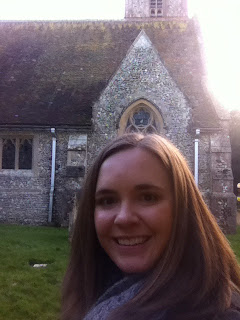It's difficult to see from this picture, but there are actually 3 front doors here, all separated from each other with a little wall in between. Very very cute! I imagine a little drafty, though.
This little house is just across the street from Jane Austen's house, Chawton House:
Technically, this was Jane's brother's house and he just let her and her sister live in it rent-free for life. Nice guy, I'd say. :) It was really just awesome. The house is not a national historical site and is maintained by the Jane Austen Society, who have tried to preserve it as close to how it was when Jane and her beloved sister Cassandra lived there. They had a few hand-written things from Jane, but no letters or manuscripts. After Jane died, her sister burned everything that she had in Jane's handwriting, believing they may later paint her in a negative light. As such, there aren't too many things left of Jane's original writings.
This is the backside of Chawton house, part of the "courtyard".
Their English Garden. It's been so mild here that flowers are already beginning to bloom.
The building at the end of the road is the Chawton library. Newer building...from the 1700s. Yeah.
The next day, Karen (my preceptor) had a meeting up by Oxford. David and I made a quick trip to Oxford and met one of their friends who lived in Oxford and went there briefly during college. Talk about an old town! Despite the fact that it's Oxford University, there is no actual university like OSU. It's more a collection of individual colleges (such as Trinity College, Magdalen (pronounced "maud-lin"), or Christ College) dispersed throughout the town. Students live in or near their college buildings, some of which date from the 700s. (Interesting fact: New College dates from the 1300s.) They don't apply to an actual university, but apply to the individual colleges. Oxford has had a very volatile history in the past, particularly with the townsfolk. Things are a little less tense now, but they still have gates up. :) These gates also make sure that those college kids get back before curfew. Otherwise they have to risk being locked out for the night or having to explain themselves to the porter, a kind of security guard/house parent.
We toured Christ College, where Lewis Carroll (real name was Charles Dodgson) lived and worked for 47 years. It was move-in day, so kids were moving back to these dorms:
I'm not even kidding. Under some of those archways, you can see doors, the entrances to the dorm rooms. Woah.
There was also this beautiful chapel (no great pictures there) that had been threatened by King Henry VIII when he was cleaning out Catholic relics from England, but with a little negotiation, they made it out relatively unscathed. Also interesting: so much of Oxford remains intact despite the bombings of England in WWII because Hitler intended to make it the capital of his new Germany, so ordered it to be left alone.
What a great little quick weekend! This weekend: Canterbury and Seven Sisters Park!
Here are a few more pictures from Oxford:
The Bridge of Sighs, totally ripped off from the Bridge of Sighs in Venice. In Venice, the bridge leads from a court building to a prison. In Oxford, it's between a library and a college. :)
This is the entrance to/exterior of Christ College. These buildings have to be washed frequently to prevent them from turning that brown (and then black) color you see here.
Part of the halls of Christ College
The courtyard of Christ College
The Great Hall. There are pictures on the wall that really look like they are following you when you walk by them. Creepy. This room had a lot of things that inspired parts of Alice in Wonderland (which Charles Dodgson created to entertain Alice, the Dean's daughter, when they were waiting for her father to show up for meals. Her father was always "late, late for a very important date!"
Trinity College

















No comments:
Post a Comment